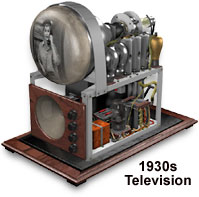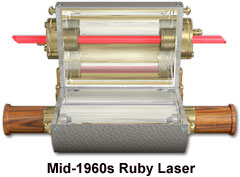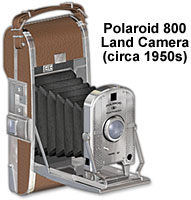
|
1934-1966
The mid-twentieth century was preoccupied with World War II and its aftermath. The subsequent Cold War between the Soviet Union and the United States put the research focus on nuclear technologies that had developed during WWII as well as the race to dominate outer space. Nevertheless, the science of optics continued to evolve at a brisk pace.

A variety of highly specialized microscopes were developed during these decades. The first transmission electron and scanning electron microscopes were built in the 1930s, making it possible to view images at much higher resolutions than had been possible with light microscopes. During the 1950s and 60s, both types of electron microscopes were refined, commercialized, and made widely available. Field-emission microscopes, developed in 1937, made it possible to view matter at the atomic level. Light microscopes continued to be refined and both still and motion cameras for microscopes were developed to record images.
In 1951, American physicist Charles Townes patented a concept for building a device that would amplify electromagnetic waves. Two years later, he built the first maser (Microwave Amplification by Stimulated Emission of Radiation) that used ammonia molecules to amplify microwave radiation. That invention led to the development of a similar device, the laser (Light Amplification by Stimulated Emission of Radiation), which amplified visible light radiation.
The first laser was built in 1960 by Theodore Maiman (USA), using a small ruby rod as its medium. The electrons of ruby atoms were energized into a highly excited state and emitted an intense beam of light as they fell back into their normal states. Since then, many other types of lasers have been developed, using different materials in solid, liquid, and gaseous states.
In 1948, Dennis Gabor, a Hungarian-born English scientist, did experiments to produce a higher resolution electron microscope using a technique he had termed wavefront reconstruction. While it fell short of his ambitions at the time, his technique found a serendipitous use in the early 1960s. Using the newly invented laser with Gabor's technique, scientists were able to create three-dimensional photographs called holograms (Greek for whole message).

Wavefront reconstruction, now called holography, is a technique for recording three-dimensional information about an image (photographs provide only two-dimensional information). More specifically, holography records detailed information about the light reflected off of an object or subject; not just the lightness, darkness, or colors of the object, but the actual patterns of the light as it is reflected. The resulting hologram appears as an unrecognizable pattern of stripes and whorls under conventional lighting, but when illuminated by a beam of laser light, the hologram displays a 3-D representation of the original object.
In the mid-1950s, scientists developed the first "imaging bundles" that would eventually lead to the development of fiber optic technology. Scientists had long been aware of the property of internal reflection that could illuminate columns of water or rods of glass or quartz. However, they had not been able to effectively utilize the principle for purposes other than entertainment or as an illuminated tongue depressor.

By 1957, the new technology was sophisticated enough to be used in surgery as a gastroscope. Fiber optic applications for the communications industry would take several more decades of technological refinements, however. In 1966, engineers Charles K. Kao and George A. Hockham, published a paper promoting the feasibility of fiber-optic technology for communications. Kao believed that most of the losses in transmitting light through glass fibers were due to absorption by impurities, most notably lead, and that those losses could be diminished enough to make fiber optics a useful medium for communications.
Television came of age after World War II, dramatically changing the way in which people obtained information and entertainment. Although a color standard was adopted in 1952, most TV stations did not begin broadcasting in color until the 1960s, when color TV sets became more affordable. The first electronic computers were developed, setting the stage for the digital revolution that would occur in the last three decades of this century.
| 1934 - 1966 |
| 1934 |
Pavel A. Cherenkov (Russia) discovers that electrons emit light (Cherenkov radiation) as they pass through a transparent medium, if they are moving faster than the speed of light for that medium. |
| 1936 |
Torbjörn Oskar Caspersson (Sweden) uses an ultraviolet microscope to study the genetic material of the cell. |
| 1937 |
Erwin W. Müller (Germany-USA) invents the field-emission microscope. This technique and a further development of it, the field ion microscope (1956), make it possible to photograph individual atoms. |
| 1938 |
James Hillier and Albert Prebus (Canada) build the first transmission magnetic electron microscope. |
| 1938 |
Frits Zernike (Holland) builds the first phase contrast microscope, for which he is awarded the Nobel Prize for Physics in 1953. The microscope makes it possible to study the internal structure of transparent cells and microorganisms without having to stain and kill the cells. |
| 1946 |
At the University of Pennsylvania, Presper Eckert and John Mauchly unveil the Electronic Numerical Integrator and Computer (ENIAC), the first general purpose electronic digital calculator. |
| 1947 |
Edwin H. Land (USA), founder of the Polaroid Corporation, publicly announces his invention of instant photography, a technique yielding photographs that self-develop within a matter of minutes. |
| 1948 |
Dennis Gabor (Hungary/England) performs his first experiments in "wavefront reconstruction," a technique designed to improve electron microscopes. In the 1960s, after the invention of the laser, his technique is renamed "holography" and is used to produce three dimensional photographs, or holograms. |
| 1949 |
W. Albert Hiltner (USA) discovers that interstellar dust particles cause a slight polarization of starlight. This provides another tool for better understanding the particles and their environment, as well as mapping the magnetic field of the Milky Way Galaxy. |
| 1950 |
Vera Cooper Rubin (USA) presents her master's thesis to the American Astronomical Society in which she suggests that galaxies might be rotating around an unknown center, not just expanding as described by the big bang theory. Controversial at the time, new findings in the early 1970s validate her thesis. |
| 1951 |
F. Roberts at the University College in London, England invents the flying spot microscope, which uses a flying spot scanner, directed through the eyepiece, as a light source to determine the features of a transparent specimen. |
| 1951 |
Erwin W. Müller and Kanwar Bahadur (USA) invent the field ion microscope, allowing atoms to be directly observed for the first time. This is a development on the field emission microscope invented by Müller in 1937. |
| 1952 |
Georges Nomarski (Poland/France) invents and patents differential interference contrast microscopy (DIC) for the light microscope. |
| 1954 |
Dutch scientist Abraham Van Heel and British scientist Harold. H. Hopkins independently publish papers on imaging bundles, which leads to the development of modern fiber optics. |
| 1955 |
Marvin Minsky (USA) invents and patents the confocal scanning microscope. Although he's built a prototype, there is little interest in the device until after the invention of the laser in the 1960s. In 1969, a laser version of the confocal microscope is developed and adopted into usage. |
| 1957 |
Physician Basil Hirschowitz (S. Africa/USA) performs the first endoscopic surgery. The fiber optic endoscope, modified as a gastroscope, had been developed by Hirschowitz along with physicists Lawrence Curtiss and C. Wilbur Peters. |
| 1957 |
Sputnik 1, the first artificial satellite put into orbit, is launched by the Soviet Union, inaugurating the Space Age. This gives astronomers the ability to make observations and measurements outside the boundaries of the Earth. |
| 1958 |
The USA launches the first three of its Pioneer spacecraft series designed for deep space exploration. While they fall short of accomplishing their missions, the first two yielded helpful data. |
| 1960 |
Theodore Maiman (USA) builds the first ruby laser at the Hughes Research Laboratories. |
| 1961 |
Ali Javan, William Bennett, and Donald Herriott construct the first gas laser (helium-neon) at Bell Laboratories (USA). |
| 1961 |
Soviet cosmonaut Yury A. Gagarin makes the first manned space flight. |
| 1964 |
Chandra K. N. Patel (USA) builds the first carbon dioxide laser at Bell Laboratories. |
| 1964 |
Emmett Leith and Juris Upatnieks of the University of Michigan produce the first holographic image or hologram. |
| 1964 |
William B. Bridges (USA) leads a group that develops the first argon laser at Hughes Aircraft Company Research Labs. |
| 1966 |
Peter P. Sorokin and J. R. Lankard (USA) build the first organic dye laser. |
| 1966 |
Electrical engineers Charles K. Kao (China) and George A. Hockham (England) publish a paper advocating the use of fiber-optic technology for communications. |
| 1966 |
Alain Werts (France) publishes a proposal similar to Kao's in a French electronics journal, but his employer, CSF, does not have the money to invest into researching his concepts. |
|
|
 |
 |
 |
BACK TO TIMELINE IN OPTICS HOME
Questions or comments? Send us an email.
© 1995-2025 by
Michael W. Davidson
and The Florida State University.
All Rights Reserved. No images, graphics, software, scripts, or applets may be reproduced or used in any manner without permission from the copyright holders. Use of this website means you agree to all of the Legal Terms and Conditions set forth by the owners.
This website is maintained by our
Graphics & Web Programming Team
in collaboration with Optical Microscopy at the
National High Magnetic Field Laboratory.
Last Modification Friday, Nov 13, 2015 at 01:18 PM
Access Count Since August 1, 2000: 61803
Visit the websites of our partners in education:
|



